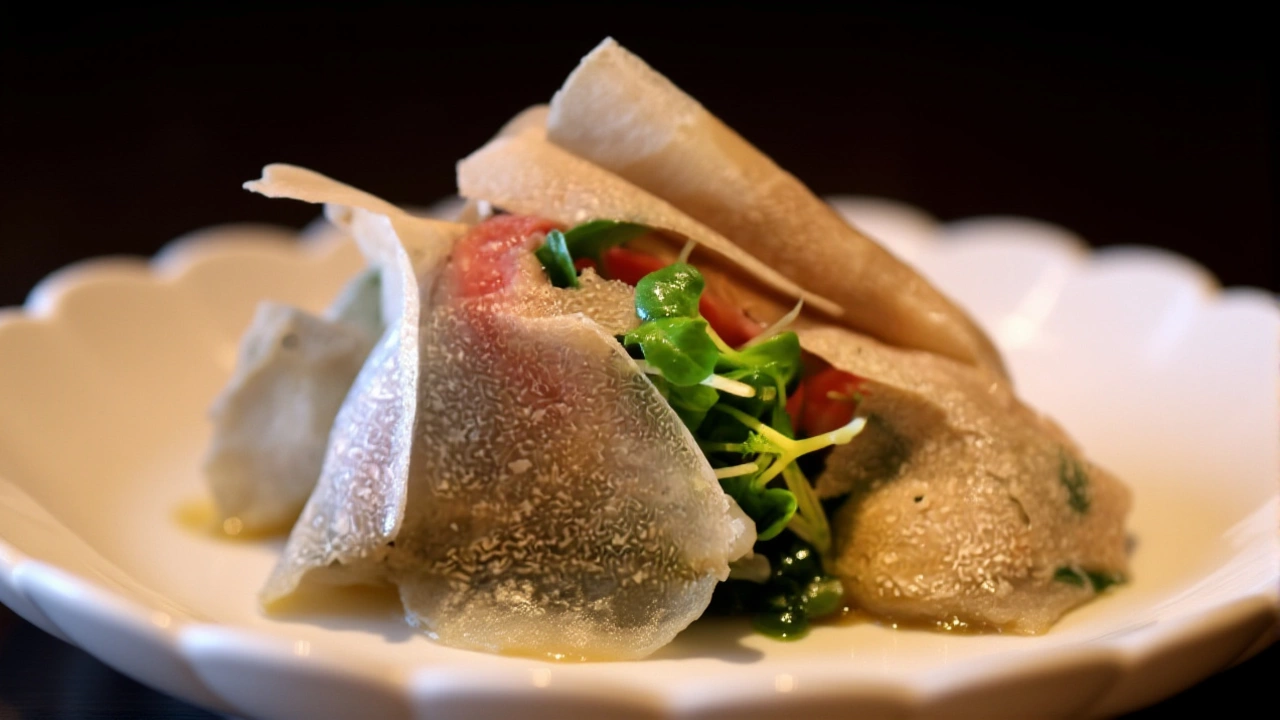Two intimate sushi counters in Boston are redefining what fine dining means in the city — not with grand chandeliers or white tablecloths, but with quiet precision, sacred wood, and fish flown in from Tokyo’s Tsukiji market. At Wa Shin and 311 Omakase, diners aren’t just eating — they’re participating in a ritual. And it’s working. Boston, long known for clam chowder and baked beans, is now being whispered about in culinary circles from New York to Tokyo as a legitimate destination for authentic, high-end omakase.
The Heart of the Counter: Wa Shin’s Philosophy of Harmony
At Wa Shin, the experience begins before you even sit down. The name — Wa (和) meaning harmony, Shin (心) meaning heart — isn’t marketing fluff. It’s the kitchen’s creed. Executive Chef Sky, a quietly intense figure with years spent training in Kyoto, crafts an 18-course journey that changes weekly, sometimes daily, based on what the fishermen bring in off the Massachusetts coast. The counter? Made of Hinoki wood, imported directly from Japan. Locals say you can smell the resin — faint, clean, almost medicinal — as you lean in to watch each piece of fish being shaped. "It’s not about showing off," Chef Sky told a small group of food writers last month. "It’s about listening. To the sea. To the season. To the person sitting across from you." His menu doesn’t list prices — until now. At $185, it’s already among the priciest in the city. But starting October 13, 2025, it climbs to $199. That’s not inflation. That’s intention. He’s capping reservations at just 12 seats per night. No walk-ins. No substitutions. "If you want to sit here," he says, "you have to be ready to let go."A Star Is Born: 311 Omakase’s Michelin Moment
Meanwhile, just a few blocks away, 311 Omakase received its first Michelin star in The MICHELIN Guide Boston 2025 — a rare honor for a restaurant with only 10 stools. The guide praised its "impressive nigiri," highlighting fluke, striped beakfish, and goldeneye snapper, all flown in from Japan’s most selective suppliers. But what stood out was the technique: a delicately fried longtooth grouper with ponzu, a simmered bowl of amadai and abalone in dashi that tasted like the ocean had been distilled into broth. "My goal," says Founder and Executive Chef Wei, "is to make something that feels Japanese, but belongs here. Boston has soul. The seafood is different. The seasons are sharper. I don’t want to replicate Tokyo. I want to honor it — and then make it mine." Unlike Wa Shin’s meditative silence, 311 Omakase hums with quiet energy. The chef speaks briefly after each course — not to explain, but to connect. "This tuna? Caught off Gloucester last Tuesday. We aged it three days. You’ll taste the salt, but also the chill of the North Atlantic."Why Boston? The City’s Quiet Culinary Transformation
Boston’s rise as a destination for omakase isn’t random. It’s the culmination of decades of change. Once a city defined by Irish pubs and Italian red sauce, it’s now home to a generation of chefs who trained in Kyoto, Osaka, and Fukuoka — then returned with a mission: to bring authenticity, not appropriation. The MICHELIN Guide put it best: "As one of the most historic cities in the United States, Boston is a vibrant culinary hub where tradition meets innovation." That’s not just poetry. It’s a report card. In South Boston, Karen Akunowicz reimagines pasta with New England shellfish. In Cambridge, restaurants balance MIT’s precision with Harvard’s poetry. And now? Two omakase counters sit at the top of the list. The city’s seafood markets — once dominated by cod and haddock — now stock uni from Hokkaido, toro from Chiba, and sea urchin from Santa Barbara. Local fishermen, once ignored by fine dining, now have direct relationships with chefs like Sky and Wei. "They call me at 4 a.m. when they’ve got something special," says one Gloucester captain. "I used to sell to the whole fish market. Now? I sell to one man. And he knows the name of every fish I catch."
The Unspoken Rule: Trust Is the Currency
Omakase — literally, "I’ll leave it up to you" — demands surrender. No menu. No choices. Just trust. And that’s what makes these two restaurants so powerful. In a world of algorithms and curated feeds, they offer something rare: human presence. Real hands shaping real food. Real eyes watching your reaction. At Wa Shin, the Hinoki wood isn’t just aesthetic. It’s spiritual. Japanese tradition holds that the wood’s natural oils calm the nerves, slow the heartbeat. Diners report feeling more present, more aware — even tearful, one wrote in a private blog. "It’s not just dinner," she said. "It’s a reset." At 311, it’s the precision. Each piece of sushi is served at exactly 98.6°F — body temperature. "That’s how the fish tastes best," Chef Wei explains. "Cold? It’s just fish. Warm? It’s memory."What’s Next for Boston’s Omakase Scene?
With Wa Shin raising prices and 311 Omakase now a Michelin-starred name, the pressure is on. Other restaurants are taking notice. A new omakase spot, Shinrin, is opening in the Back Bay this fall with a 22-course tasting. A former apprentice of Chef Sky is rumored to be launching his own counter in Brookline. And the Boston Food & Wine Festival just added its first omakase tasting event — sold out in 48 hours. But the real question isn’t how many will open. It’s whether Boston can sustain them. Can the city support multiple high-end omakase counters? Can diners afford $200 meals on a regular basis? And more importantly — will they keep coming back, not for Instagram, but for the quiet, sacred act of being fed by someone who knows your name?
Behind the Counter: The Human Element
What’s often missed in reviews is the exhaustion behind the elegance. Chef Sky works 16-hour days. He doesn’t take vacations. His wife says he dreams in fish. Chef Wei, who once worked in a Brooklyn ramen shop, now sleeps only four hours a night. "I’m not trying to be famous," he says. "I’m trying to make something that lasts." And maybe that’s the real story. Not the price tags. Not the stars. But the quiet, relentless devotion of two chefs who chose to build something small — and beautiful — in a city that’s finally ready to listen.Frequently Asked Questions
How does the omakase experience differ from a regular sushi dinner?
Unlike a traditional sushi menu where you pick dishes, omakase means you surrender control to the chef. At Wa Shin and 311 Omakase, guests receive a personalized sequence of 18–22 courses, each crafted based on daily market finds and the diner’s subtle cues. No two meals are alike — and the experience is designed to engage all five senses, not just taste.
Why is the Hinoki wood counter at Wa Shin significant?
Hinoki, a sacred Japanese cypress, is believed to have calming, purifying properties in traditional Shinto culture. Imported directly from Japan, the counter at Wa Shin isn’t just furniture — it’s part of the ritual. Diners report a noticeable sense of calm, and chefs say the wood’s natural oils subtly enhance the dining atmosphere, creating a sensory bridge between Japan and Boston.
What makes 311 Omakase’s Michelin star different from other Boston restaurants?
311 Omakase is one of only two Michelin-starred omakase experiences in New England. Its star reflects not just ingredient quality — like imported Japanese fluke and abalone — but technical mastery, consistency, and an immersive dining philosophy. Unlike many starred restaurants, it operates with just 10 seats, making each meal a rare, intimate event that’s nearly impossible to book.
Are these restaurants accessible to locals, or just tourists?
While both attract visitors, the majority of diners are Boston residents. Wa Shin reports that 68% of its guests are from Greater Boston, many returning monthly. 311 Omakase has a waitlist of over 1,200 names — mostly locals who’ve been trying for months. The price point is steep, but the loyalty is real. For many, it’s not a treat — it’s a tradition.
Why did Wa Shin raise its price to $199 starting October 13, 2025?
The increase reflects rising costs of importing premium Japanese seafood, maintaining the Hinoki counter, and compensating staff for extended hours. But more than that, it’s a statement. Chef Sky is deliberately limiting capacity to preserve quality and exclusivity. The new price isn’t about profit — it’s about protecting the integrity of the experience.
Is omakase just a trend, or is it here to stay in Boston?
This isn’t a trend — it’s a maturation. Boston’s culinary identity has evolved beyond lobster rolls and clam chowder. The presence of two distinct, critically acclaimed omakase counters — each with deep philosophy and local ties — signals a permanent shift. With more chefs training in Japan and diners seeking meaningful experiences, omakase is becoming a cornerstone of Boston’s fine dining future.
